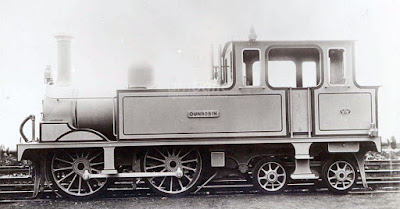Some notes on the livery of Dunrobin 1895 to 1965
Dunrobin’s livery can be generalised as described in Cormack and Stevenson's, Highland Railway Locomotives Book 2 “…dark green with black lining double-edged in gold.” This livery was carried throughout the engine’s varied career.
 |
| Photo Paul Moore |
I received the accompanying photos of Dunrobin from Paul Moore this week, he painted and lined the model and has done a great job on it. It was intended to depict the engine in its earliest livery in the service of the duke of Sutherland, so reference was made to the photograph of Dunrobin of 1895 which shows the engine newly built at the Atlas Works of Sharp Stewart in Glasgow. The engine is shown in works grey and displays an elaborate though elegantly designed livery with double-edged lining in panels with a black border. The angle of the photo does not allow detail to be seen of the buffer beam, nor the tank front, cab front or the rear of the bunker.
A photo from the Highland News of 17 Sept.1921 shows Dunrobin under the station canopy at Inverness decorated with a leek in front of the chimney, awaiting the arrival of the Prince of Wales. Closer inspection of the photo reveals a rather different livery to that shown in earlier photos, Dunrobin appears to have been recently refurbished in response to the royal visit. The black border to the lining on the tank and cab sides has gone, though it is retained on the front splasher. The lining panels, though still the same black double-edged gold as before, have been widened on the tank sides and double edged-lining can also be seen on the cab front and tank front. Evidence does not confirm that there was a panel of lining on the tank front earlier than this photo. An earlier photo does however show that there was no panel of lining on the cab front before 1921 and this is reflected by the model. It is probable, though the photo is not clear enough to confirm this, that the lining on the tank sides was changed at this time from a simple rectangle to a shape that enclosed the side window.
The 1921 photo provides the first evidence of how the buffer beam was lined and panelled, it is thought that the buffer beam remained essentially unchanged throughout Dunrobin’s chequered history... green with a red central panel lined black. The buffer shanks may have been green originally too, or possibly red, there is no conclusive evidence. I like them green, so green it is for the model.
 |
| Dunrobin at Inverness 1921 |
It is intended to put the preserved Dunrobin into service in as near as possible original condition and carrying the pre-1921 livery, based on the works grey photo. After much deliberation Paul Jarman and his team at Beamish have decided that the full size engine will look the part in classy Landrover Bronze Green. Dunrobin’s original dark green was not Highland Railway green, nor was it the blue-green in which she was repatriated from Canada in 2011. Though the lining is described as “black, double-edged gold” this is not thought to refer to a metallic gold, but rather to a colour somewhere between straw and yellow.
Paul Moore mixed the basic green for the model Dunrobin, it is not Landrover Green, it is his interpretation of the colour of the engine and the black double edged straw/gold lining was agreed between ourselves as being the most likely as well as the best looking lining to enliven the overall green. The brass incised nameplate was commissioned from Narrow Planet.
 |
| Dunrobin 1899 in works grey. Photo courtesy of the HRSoc |
 |
| Photo Paul Moore |
In 1946, after war service with the Royal Navy, Dunrobin was overhauled and repainted with the lining following the previous scheme of 1921.
In 1949, the duke sold Dunrobin to Capt. Howey of the Romney, Hyth and Dimchurch Railway and in 1950 the engine travelled to New Romney partly under her own steam. Publicity surrounding the event led to a renewal of interest and a large number of photos which record the engine showing the livery unchanged during this period.
Initial interest waned and by 1965 Dunrobin was in the doldrums, she was sold to Harold Foster of British Columbia and shipped to Canada. Many changes were made during her 46 years of exile, which have fortunately now been removed at Beamish Museum, her new home.
 |
| If you look carefully you can see that this photo of 1902 shows Dunrobin in the livery of the works grey photo of 1895 |

No comments:
Post a Comment